Getting the right wheels for your vehicle isn’t just about style and size – it’s about safety and proper fitment. The lug pattern, also known as bolt pattern or PCD (pitch circle diameter), determines whether your wheels will actually fit your car’s hub assembly.
We’ve all been there: you find the perfect set of wheels online, only to discover they won’t mount properly because you didn’t check the lug pattern first. This costly mistake happens more often than you’d think, and it’s completely avoidable with the right knowledge.
Learning how to measure your vehicle’s lug pattern accurately takes just a few minutes and can save you hundreds of dollars in returns or exchanges. Whether you’re upgrading to aftermarket wheels or replacing damaged ones, we’ll walk you through the simple tools and techniques you need to get precise measurements every time.
What Is a Lug Pattern and Why Does It Matter
A lug pattern represents the exact arrangement of bolt holes on your vehicle’s wheel hub. The pattern consists of two measurements: the number of bolt holes and the diameter of the circle formed by those holes’ centers. We commonly express this as a format like 5×114.3, where 5 indicates the number of bolts and 114.3 represents the bolt circle diameter in millimeters.
Automakers design each vehicle with a unique lug pattern that corresponds to the wheel’s mounting system. This pattern serves as the primary connection point between your wheel and vehicle, distributing the weight and forces across multiple contact points. The bolt circle diameter varies significantly between manufacturers, with common measurements including 100mm, 108mm, 112mm, 114.3mm, 120mm, and 127mm.
Vehicle safety depends entirely on matching the correct lug pattern to your exact make and model. Installing wheels with an incorrect pattern creates dangerous gaps or misalignments that compromise the wheel’s ability to secure properly to the hub. These misalignments can cause wheel wobbling, uneven tire wear, and in extreme cases, complete wheel separation while driving.
Performance implications extend beyond safety concerns when using mismatched lug patterns. Improper fitment affects your vehicle’s handling characteristics, braking efficiency, and suspension geometry. The wheel’s center bore and offset work along with the lug pattern to maintain proper alignment and weight distribution across the vehicle’s contact patches.
| Lug Pattern | Common Vehicles | Bolt Circle Diameter |
|---|---|---|
| 4×100 | Honda Civic, Toyota Corolla | 100mm |
| 5×114.3 | Ford Mustang, Nissan Altima | 114.3mm |
| 5×120 | BMW 3 Series, Chevrolet Camaro | 120mm |
| 6×139.7 | Toyota Tacoma, Chevrolet Silverado | 139.7mm |
Measuring your lug pattern accurately prevents costly wheel returns and ensures optimal vehicle performance. The measurement process requires basic tools and follows exact techniques depending on whether your vehicle has an even or odd number of bolt holes. Understanding these measurement methods enables you to confidently select aftermarket wheels that enhance both your vehicle’s appearance and functionality.
Tools You Need to Measure Lug Pattern
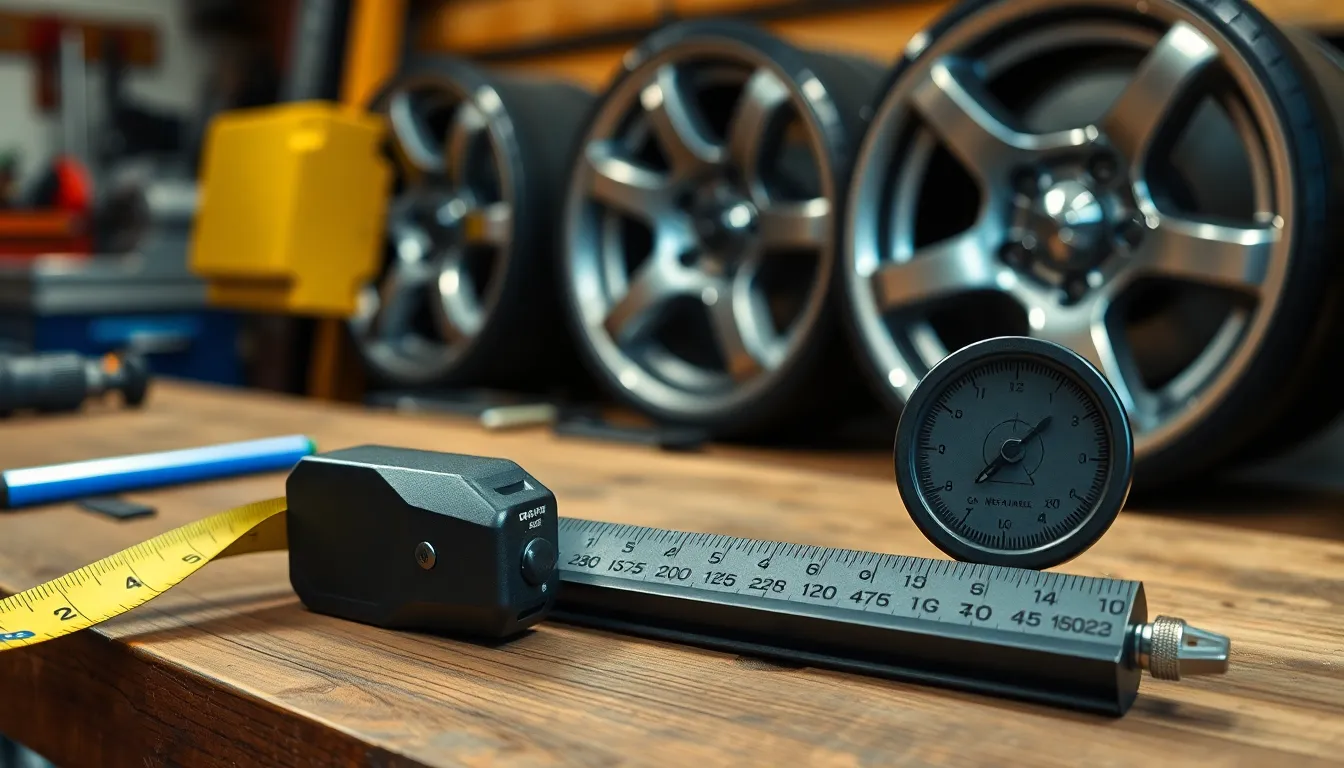
Measuring your vehicle’s lug pattern requires simple tools that most car owners already have in their garage or toolbox. We recommend starting with a standard ruler or tape measure, which provides sufficient accuracy for most lug pattern measurements. Metric rulers work best since they match common automotive industry standards.
Basic Measurement Tools
A tape measure offers the most versatility when measuring different wheel sizes and lug patterns. Standard rulers work effectively for smaller wheels but may become challenging to use on larger diameter patterns. Both tools deliver accurate results when positioned correctly from center to center of the lug holes.
Specialized Bolt Pattern Gauges
Bolt pattern gauges provide enhanced precision for complex measurements, particularly when dealing with odd numbered lug patterns like 5 lug configurations. These specialized tools eliminate guesswork and reduce measurement errors. Professional mechanics often use these gauges for rapid, consistent measurements across multiple vehicles.
Measurement Tool Selection Guide
| Tool Type | Best For | Accuracy Level |
|---|---|---|
| Ruler | 4 lug patterns | Standard |
| Tape Measure | All patterns | High |
| Bolt Pattern Gauge | Complex patterns | Professional |
Digital Measuring Tools
Digital calipers offer precise measurements for mechanics who require exact specifications. These tools work particularly well for measuring smaller bolt patterns or when working with custom wheel applications. Many digital calipers display measurements in both metric and imperial units, providing flexibility for different measurement preferences.
We find that having multiple measurement tools available ensures accuracy regardless of your wheel configuration. Start with a basic tape measure, then consider upgrading to specialized gauges if you frequently work with various lug patterns.
How to Measure 4-Lug and 6-Lug Patterns

Even numbered lug patterns offer the simplest measurement approach since opposite bolt holes align directly across from each other. We can achieve accurate measurements by identifying opposing lugs and measuring the distance between their centers.
Measuring 4-Lug Patterns
Count the lug holes to confirm your wheel has exactly 4 mounting points. Locate two lug holes positioned directly opposite each other across the wheel’s center. Measure the distance from the center of one lug hole to the center of the opposite lug hole using your tape measure or caliper.
This center to center measurement gives you the bolt circle diameter (BCD). Express your 4-lug pattern as the number of lugs followed by the BCD measurement. A 4-lug wheel with a 100mm BCD becomes 4x100mm in standard notation.
Measuring 6-Lug Patterns
Verify your wheel contains 6 lug holes before beginning measurement. Identify two lug holes positioned directly across from each other through the wheel’s center point. Take the center to center measurement between these opposing lug holes to determine the bolt circle diameter.
Record this measurement as your BCD value for the 6-lug pattern. A 6-lug wheel measuring 135mm between opposing centers translates to 6x135mm pattern designation. Double check your measurement by taking a second reading between different opposing lugs to ensure accuracy.
How to Measure 5-Lug Patterns
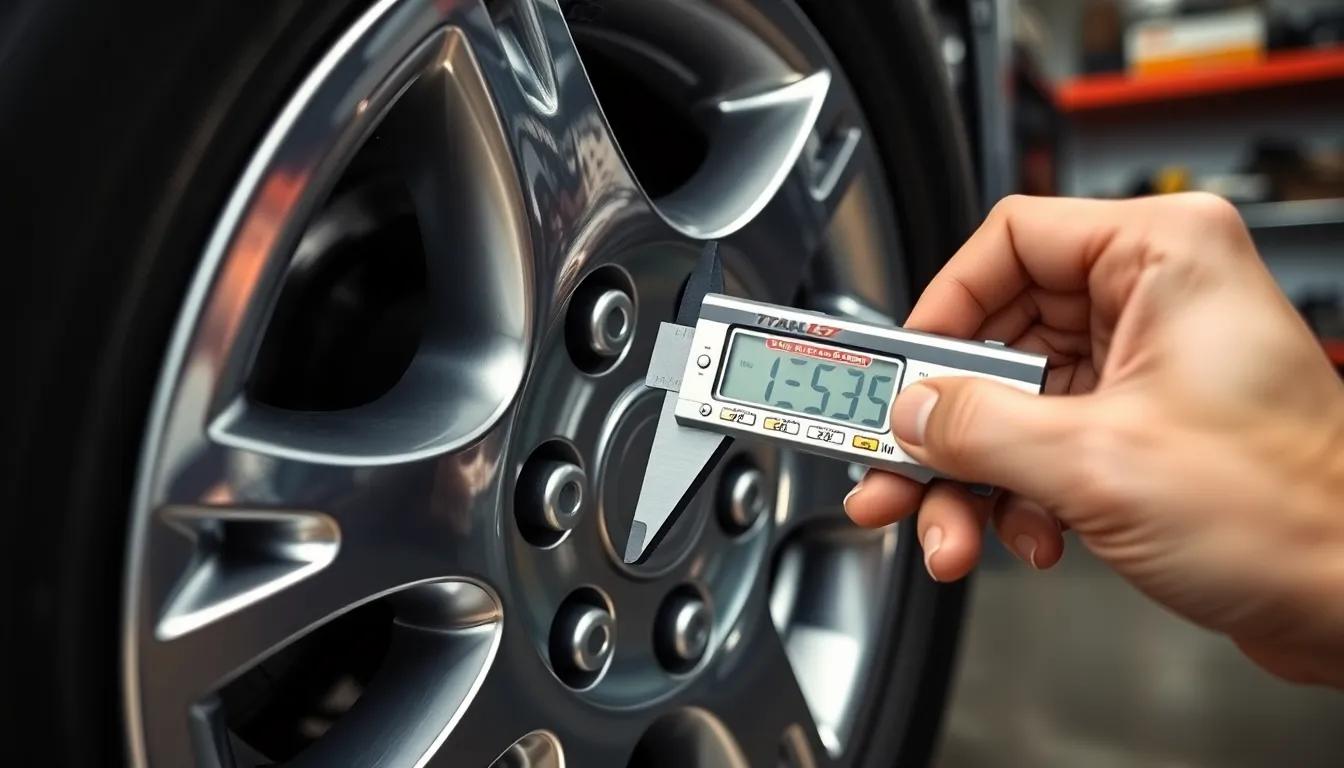
Measuring 5-lug wheel patterns requires a different approach than even-numbered configurations. Unlike 4-lug or 6-lug patterns where holes align directly opposite each other, 5-lug arrangements create an odd-numbered circle that demands exact measurement techniques.
Understanding 5-Lug Configuration
We encounter unique challenges with 5-lug patterns since no two holes sit directly across from each other. Each lug hole positions itself at 72-degree intervals around the circle, creating a pentagon-shaped arrangement. The measurement process involves identifying the correct reference points to determine the bolt circle diameter accurately.
Step-by-Step Measurement Process
First, we count the lug holes to confirm a 5-lug pattern exists on our wheel hub. Next, we select one lug hole as our starting reference point and locate the lug hole positioned farthest from it. This target hole sits two positions away clockwise or counterclockwise from our starting point, not the adjacent holes.
We measure from the center of our reference lug hole to the center of the farthest lug hole using a tape measure or caliper. The distance between these center points represents the bolt circle diameter. Recording this measurement in millimeters provides the most accurate results for wheel fitment verification.
Measurement Tools and Accuracy
Using digital calipers delivers the highest precision for 5-lug pattern measurements. Standard tape measures work effectively for basic measurements, though metric rulers provide better accuracy than imperial measurements. We verify our measurement by repeating the process with different lug hole pairs to ensure consistency.
Pattern Notation Examples
Common 5-lug patterns include 5×114.3mm, 5x120mm, and 5x100mm configurations. The first number indicates five lug holes, while the second number represents our measured bolt circle diameter. For example, measuring 114.3mm between center points of the farthest lug holes creates a 5×114.3 bolt pattern specification.
Verification Techniques
We double-check our measurements by consulting the vehicle owner’s manual or wheel specifications when available. Cross-referencing our measured values with manufacturer specifications confirms accuracy before purchasing new wheels. Taking multiple measurements from different lug hole pairs helps identify any measurement errors or hub damage that might affect our results.
How to Measure 8-Lug Patterns

Measuring 8-lug patterns requires the same foundational approach we use for other even-numbered configurations. We count the lug holes to confirm 8 positions arranged around the wheel hub. Eight-lug patterns appear most commonly on heavy-duty trucks, commercial vehicles, and some large SUVs where additional bolt strength supports greater load capacity.
Direct measurement across opposing holes provides the most accurate method for 8-lug patterns. We locate one lug hole and identify the hole positioned directly across from it on the opposite side. The distance between these center points gives us the bolt circle diameter measurement we need for proper wheel fitment.
We can also measure between adjacent holes if accessing opposing holes proves difficult. This technique involves measuring from one lug hole center to the center of the next hole in sequence. The measurement requires mathematical conversion to determine the actual bolt circle diameter, making the direct opposing method more reliable for accurate results.
Verification steps ensure measurement accuracy for 8-lug configurations. We double-check our measurements using a second method or measuring tool. Digital calipers provide enhanced precision compared to standard tape measures, particularly when working with larger bolt circle diameters common in 8-lug applications.
Common 8-lug patterns include 8×165.1mm (found on many Chevrolet and GMC trucks), 8x170mm (typical for Ford Super Duty trucks), and 8x200mm (used on some heavy-duty commercial applications). We express these measurements using standard notation where the first number indicates 8 lug holes and the second number represents the bolt circle diameter in millimeters.
Cross-referencing vehicle specifications confirms our measurements before purchasing wheels. We check the owner’s manual or existing wheel markings to verify our measured bolt pattern matches manufacturer specifications. This validation step prevents costly fitment errors and ensures proper wheel installation for optimal vehicle safety and performance.
Common Lug Pattern Measurements and Vehicle Applications
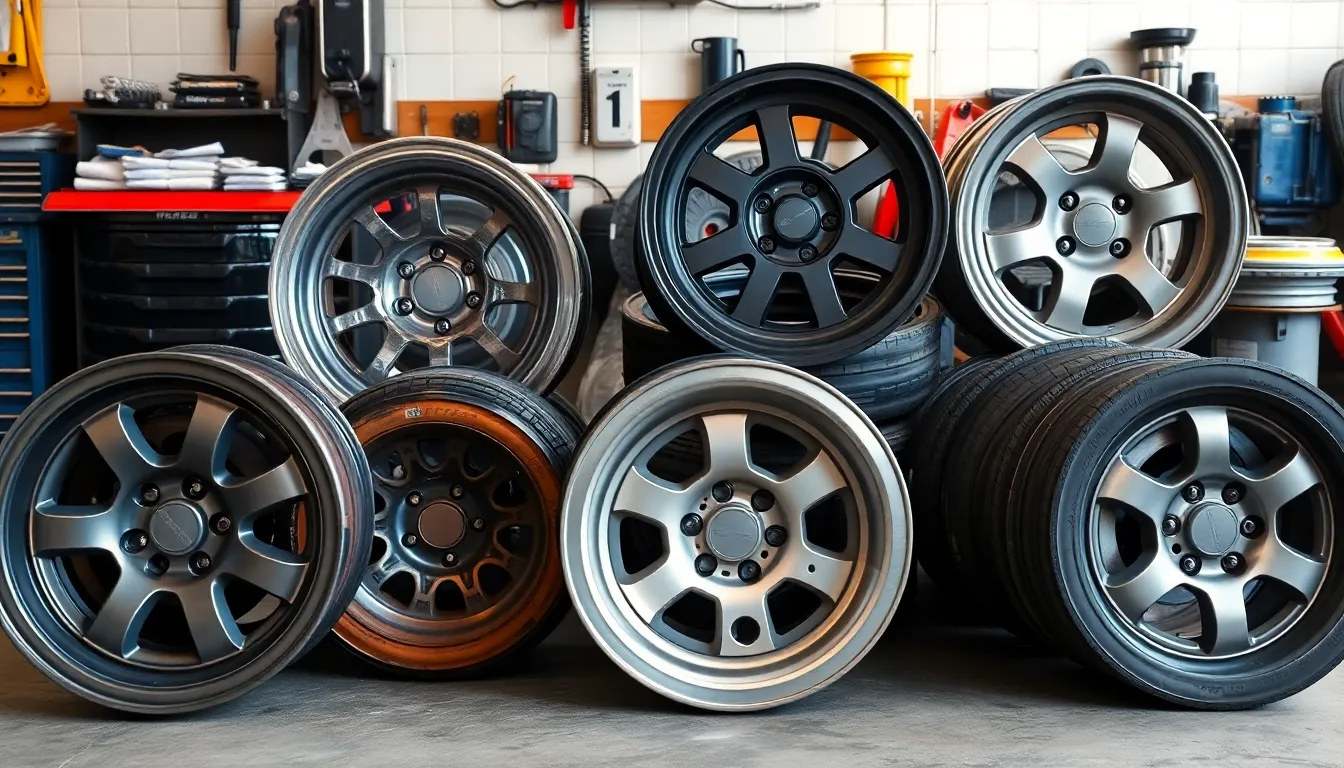
Understanding exact lug pattern measurements helps determine which vehicles use particular wheel configurations. Different vehicle types use distinct lug patterns based on weight requirements and engineering specifications.
Standard 4-Lug Patterns
4-lug patterns appear primarily on small cars and light vehicles where reduced weight and manufacturing costs take priority. The 4×100 pattern represents one of the most common configurations, fitting vehicles like older Honda Civics and Toyota Corollas. Measuring these patterns requires identifying two opposing lug holes and recording the center-to-center distance, which equals the bolt circle diameter.
Compact cars frequently use 4×100 measurements due to their lightweight design requirements. European vehicles sometimes employ 4×108 patterns, while certain domestic models use 4×114.3 configurations. These patterns provide adequate strength for vehicles under 3,000 pounds while maintaining cost-effective manufacturing processes.
Standard 5-Lug Patterns
5-lug patterns dominate the passenger car market, appearing on most sedans, SUVs, and light trucks manufactured today. The 5×114.3 pattern serves as the industry standard for Japanese and Korean vehicle manufacturers, including Honda, Toyota, Nissan, and Hyundai models. Measuring these patterns involves selecting one lug hole and measuring to the outer edge of the lug hole positioned farthest away.
Many European vehicles use 5×120 patterns, commonly found on BMW and certain Mercedes-Benz models. Domestic manufacturers often employ 5×114.3 or 5×127 configurations depending on vehicle size and intended use. These patterns balance strength requirements with manufacturing efficiency across diverse vehicle applications.
Standard 6-Lug and 8-Lug Patterns
6-lug patterns appear predominantly on larger trucks and SUVs requiring enhanced load-bearing capacity. The 6×139.7 pattern dominates the full-size truck market, fitting vehicles like Chevrolet Silverado, GMC Sierra, and Toyota Tacoma models. Measuring involves locating opposing lug holes and recording the center-to-center distance for accurate bolt circle diameter determination.
8-lug patterns serve heavy-duty pickup trucks and commercial vehicles designed for maximum towing and payload capacity. The 8×165.1 measurement fits many Ford Super Duty trucks, while 8×170 patterns appear on certain heavy-duty applications. These configurations provide superior strength distribution across multiple mounting points, ensuring safe operation under extreme loading conditions.
Heavy-duty applications require these robust patterns to handle increased stress from towing, hauling, and commercial use scenarios. The additional lug holes distribute forces more evenly across the wheel mounting surface, reducing individual stud stress and improving overall safety margins.
Tips for Accurate Lug Pattern Measurement
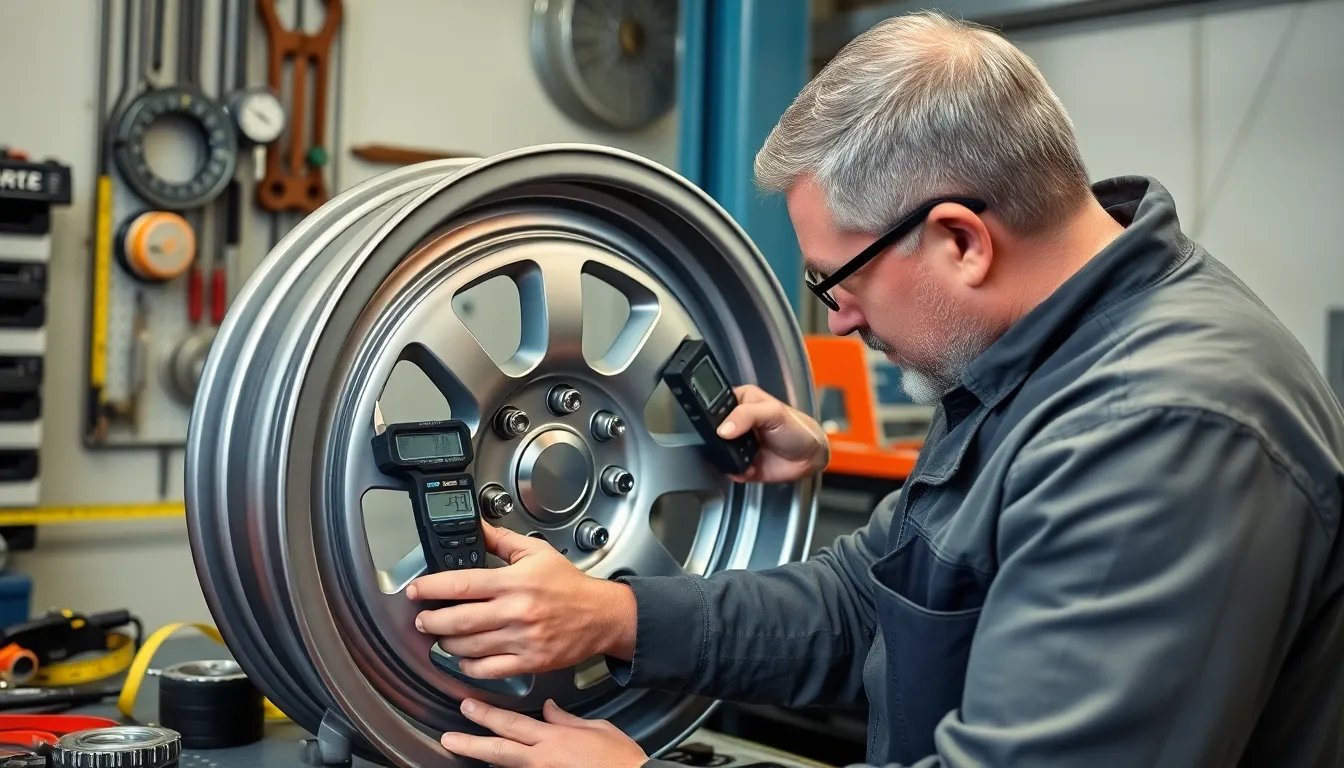
We recommend using digital calipers or a precise tape measure for the most accurate lug pattern measurements. Digital calipers provide measurements within 0.01mm precision, making them ideal for custom applications and odd-numbered patterns. Tape measures work effectively for basic measurements, though we suggest using metric rulers since most lug patterns are expressed in millimeters.
Essential Measurement Techniques
We measure multiple times to ensure consistency across different lug hole positions. Starting with one lug hole, we take measurements to opposing holes and compare the results. Variations exceeding 1-2mm indicate measurement errors or wheel damage that requires investigation.
We verify our measurements against manufacturer charts exact to our vehicle’s make, model, and year. Vehicle specifications provide the definitive lug pattern reference, allowing us to confirm our measurements before purchasing new wheels.
Specialized Tools for Complex Patterns
We use bolt circle gauges for 5-lug and other odd-numbered patterns where direct measurement proves challenging. These specialized tools eliminate calculation errors and provide instant pattern identification. Bolt pattern gauge tools are available for the most common configurations, including 5×114.3mm and 5x120mm patterns.
We position the gauge over the wheel’s lug holes and identify the matching pattern template. This method proves particularly valuable for 5-lug wheels where measuring from center to center requires skipping one lug hole position.
Measurement Accuracy Guidelines
| Tool Type | Accuracy Level | Best Application |
|---|---|---|
| Digital Calipers | ±0.01mm | Custom wheels, precision fitment |
| Bolt Circle Gauge | ±0.5mm | Standard patterns, quick identification |
| Tape Measure | ±1mm | Basic measurements, field checks |
We check our measurements from multiple angles to account for wheel manufacturing tolerances. Even small discrepancies can indicate measurement errors or require professional verification for safety compliance.
We document our measurements and cross-reference them with at least two different sources before making wheel purchases. Accuracy remains critical for vehicle safety and proper wheel fitment, preventing dangerous misalignments and costly returns.
Common Mistakes to Avoid When Measuring
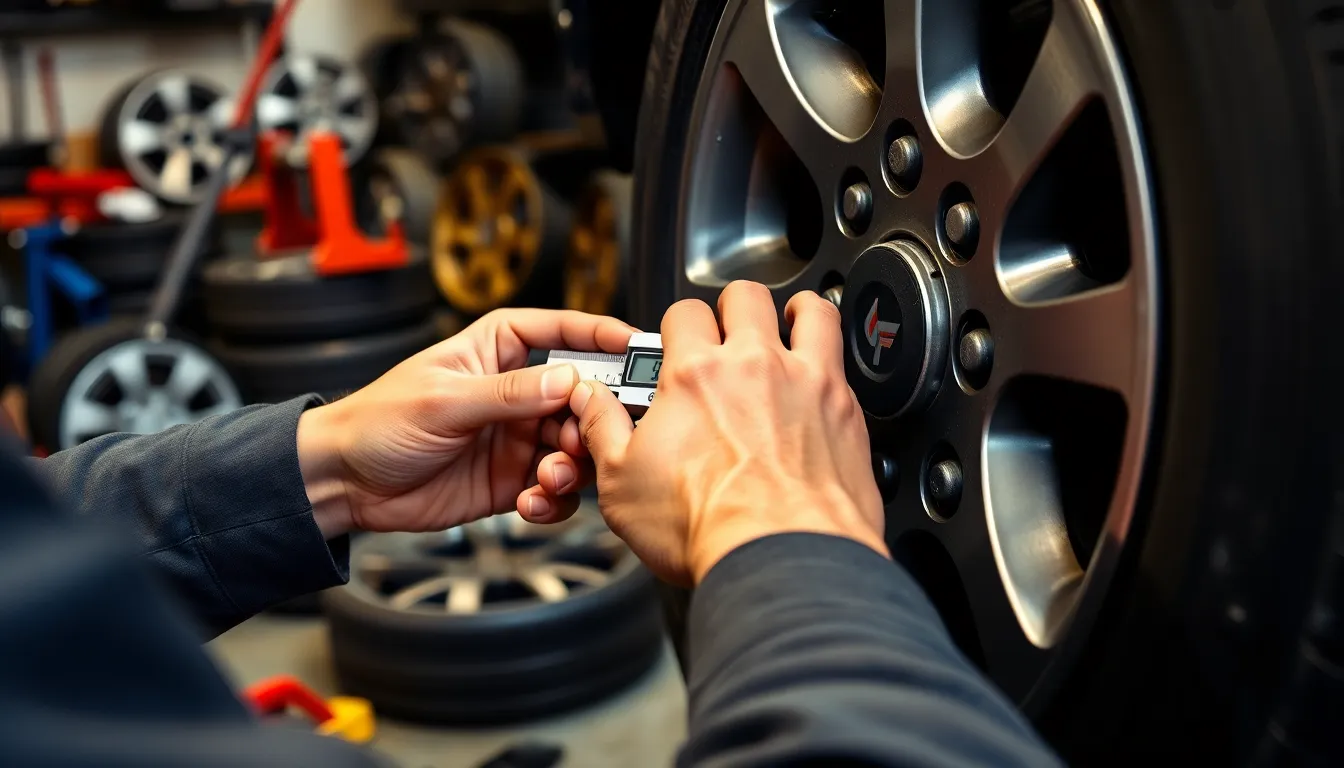
Measuring lug patterns incorrectly leads to costly wheel purchases and potential safety hazards. We’ve identified the most frequent errors that vehicle owners make during the measurement process.
Measuring 5-lug patterns center to center represents the most common mistake we encounter. Vehicle owners often attempt to measure directly across from one lug hole center to another center point but this approach fails because no lug hole sits directly opposite in a 5-lug configuration. Proper measurement requires measuring from one lug center to the back edge of the farthest lug hole.
Inaccurate lug hole center identification causes measurement errors that compound throughout the process. Many people measure from the edge of lug holes rather than their precise centers which results in incorrect bolt circle diameter calculations. Digital calipers help ensure measurements originate from the exact center point of each hole.
Confusing lug count with bolt circle diameter creates specification errors that prevent proper wheel fitment. We recommend counting all visible lug holes twice before beginning measurements since some patterns like 8-lug configurations can appear similar to 6-lug patterns from certain angles. Recording both numbers separately prevents mixing up the lug count with the diameter measurement.
Using inappropriate measuring tools compromises measurement accuracy across all lug pattern types. Standard household rulers lack the precision needed for automotive applications while cloth tape measures stretch under tension. We suggest using rigid metal rulers or specialized bolt pattern gauges that maintain consistent measurements.
Assuming incorrect measurement units creates important fitment problems since automotive specifications typically use millimeters. Converting between inches and millimeters incorrectly or assuming the wrong unit system entirely leads to purchasing wheels with completely different specifications. Always verify whether your measurements match manufacturer specifications in the correct units.
Measuring only once without verification increases the likelihood of errors that expensive mistakes follow. We recommend taking measurements from multiple angles and comparing results to manufacturer specifications before finalizing any wheel purchase decisions.
Conclusion
We’ve covered the essential steps to accurately measure your vehicle’s lug pattern using basic tools you likely already own. Taking precise measurements isn’t just about finding the right wheels – it’s about ensuring your safety on the road and avoiding costly mistakes.
Remember that different lug configurations require exact measurement techniques. Even-numbered patterns offer straightforward center-to-center measurements while odd-numbered patterns need careful attention to positioning and specialized approaches.
The time you spend measuring correctly now will save you from returns shipping costs and potential safety hazards down the road. Whether you’re upgrading for style or replacing worn wheels we can’t stress enough how critical proper fitment is for your vehicle’s performance and your peace of mind.
Frequently Asked Questions
What is a lug pattern and why is it important?
A lug pattern (or bolt pattern) represents the arrangement of bolt holes on your vehicle’s wheel hub. It consists of the number of bolt holes and the diameter of the circle they form. This pattern is crucial for vehicle safety because mismatched patterns can cause dangerous wheel wobbling, misalignments, and even complete wheel separation while driving.
What tools do I need to measure my vehicle’s lug pattern?
You can start with basic tools like a standard ruler or tape measure, with metric rulers being preferable for accuracy. For more precision, consider digital calipers or specialized bolt pattern gauges, especially for complex odd-numbered patterns like 5-lug configurations. These tools help ensure accurate measurements and prevent costly fitment errors.
How do I measure a 4-lug or 6-lug pattern?
For even-numbered patterns (4-lug or 6-lug), count the lug holes first, then locate two opposing holes that align directly across from each other. Measure the distance between the centers of these opposing holes to determine the bolt circle diameter (BCD). Express this as standard notation, like 4x100mm or 6x135mm.
How is measuring a 5-lug pattern different?
5-lug patterns require a different approach since holes don’t align directly opposite each other. They form a pentagon with holes at 72-degree intervals. Select a reference lug hole and measure the distance to the farthest hole (two positions away). Digital calipers are recommended for precision, and always verify against vehicle specifications.
What are the most common lug patterns for different vehicle types?
Small cars typically use 4-lug patterns like 4x100mm. Passenger cars commonly use 5-lug patterns, with 5×114.3mm being an industry standard. Larger trucks and SUVs often feature 6-lug patterns, while heavy-duty trucks use 8-lug patterns like 8×165.1mm or 8x170mm for extreme loading conditions.
What mistakes should I avoid when measuring lug patterns?
Never attempt to measure 5-lug patterns directly across opposing holes, as this leads to inaccurate results. Always identify the exact center of lug holes, use appropriate measuring tools for your pattern type, and double-check measurement units (metric vs. imperial). Verify measurements multiple times for consistency before purchasing wheels.
How can I verify my lug pattern measurements are correct?
Cross-reference your measurements against manufacturer charts specific to your vehicle’s make, model, and year. Measure multiple times to ensure consistency, and consider using specialized bolt circle gauges for complex patterns. Always verify measurement units and compare results with official vehicle specifications to prevent costly fitment errors.





